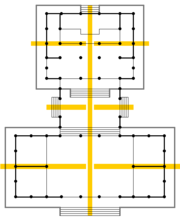
Ishi-no-ma-zukuri
Encyclopedia

Haiden (Shinto)
In Shinto shrine architecture, the is the hall of worship or oratory. It is generally placed in front of the shrine's main sanctuary and often built on a larger scale than the latter. The haiden is often connected to the honden by a heiden, or hall of offerings...
, or worship hall, and the honden
Honden
The , is the most sacred building at a Shinto shrine, intended purely for the use of the enshrined kami, usually symbolized by a mirror or sometimes by a statue. The building is normally in the rear of the shrine and closed to the general public. In front of its usually stands the haiden, or...
, or main sanctuary, are interconnected under the same roof in the shape of an H.
The connecting passage can be called , , or . The floor of each of the three halls can be at a different level. If the ai-no-ma is paved with stones it is called ishi-no-ma, whence the name of the style. It can however be paved with planks or tatami
Tatami
A is a type of mat used as a flooring material in traditional Japanese-style rooms. Traditionally made of rice straw to form the core , with a covering of woven soft rush straw, tatami are made in standard sizes, with the length exactly twice the width...
. Its width is often the same as the honden's, with the haiden from one to three ken wider.
This style, rather than the structure of a building, defines the relationship between member structures of a shrine. Each member then belongs to a particular architectural style. For example, the honden and haiden at are single-storied, irimoya-zukuri edifices. Because they are connected by a passage called ishi-no-ma and are covered by a single roof, however, the complex is classified as belonging to the ishi-no-ma-zukuri style.
One of the oldest examples is Kitano Tenman-gū
Kitano Tenman-gu
' is a Shinto shrine in Kamigyō-ku, Kyoto, Japan.-History:It was built in 947, to appease the angry spirit of bureaucrat, scholar and poet Sugawara no Michizane, who had been exiled as a result of political maneuvers of his enemies in the Fujiwara clan....
in Kyoto
Kyoto
is a city in the central part of the island of Honshū, Japan. It has a population close to 1.5 million. Formerly the imperial capital of Japan, it is now the capital of Kyoto Prefecture, as well as a major part of the Osaka-Kobe-Kyoto metropolitan area.-History:...
. The gongen-zukuri name comes from Nikkō Tōshō-gū
Nikko Tosho-gu
is a Shinto shrine located in Nikkō, Tochigi Prefecture, Japan. It is part of the "Shrines and Temples of Nikkō", a UNESCO World Heritage Site.Tōshō-gū is dedicated to Tokugawa Ieyasu, the founder of the Tokugawa shogunate. Initially built in 1617, during the Edo period, while Ieyasu's son Hidetada...
in Nikkō, which enshrines the Tōshō Daigongen (Tokugawa Ieyasu
Tokugawa Ieyasu
was the founder and first shogun of the Tokugawa shogunate of Japan , which ruled from the Battle of Sekigahara in 1600 until the Meiji Restoration in 1868. Ieyasu seized power in 1600, received appointment as shogun in 1603, abdicated from office in 1605, but...
) and adopts this structure.

